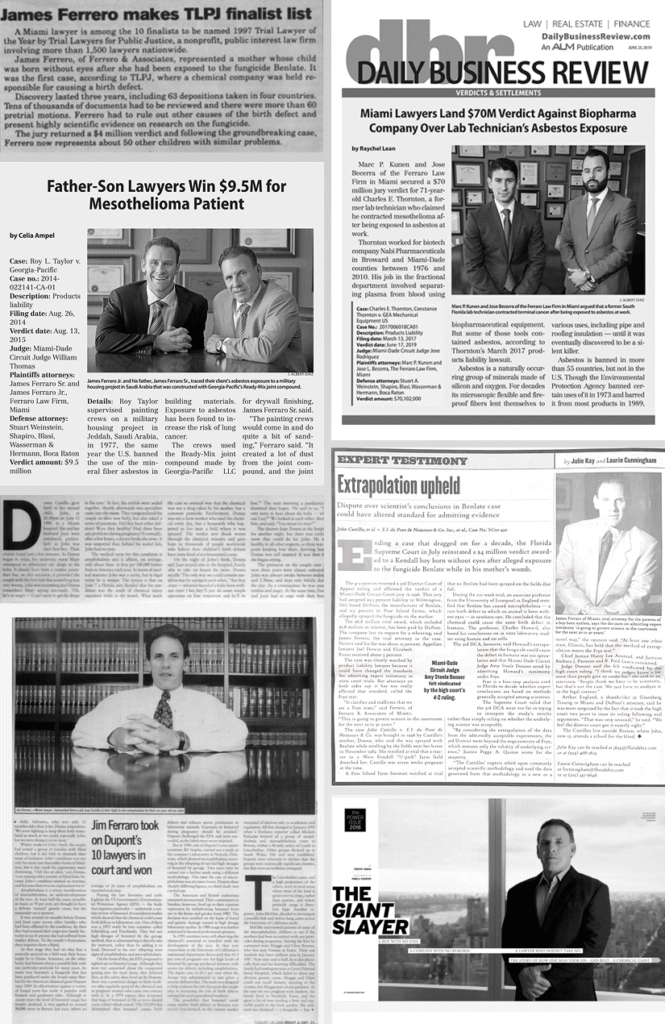At Ferraro Law, we recognized the life-altering consequences that PCBs (polychlorinated biphenyls) inflicted on individuals, families, and communities. Once hailed for their versatility in electrical equipment such as PCBs transformers, PCBs capacitors, and old fluorescent lighting fixtures, these toxic substances are now understood to be human carcinogens with wide-ranging effects on human health. When PCBs contamination spreads through municipal or other landfills, hazardous waste sites, or illegal or improper dumping, it can taint our food chain, contaminate drinking water, and contaminate air—posing extensive health hazards.
Ferraro Law helped those exposed to PCBs pursue justice and compensation for medical bills, emotional trauma, and the long-term impacts of these dangerous PCB chemicals.
Understanding PCBs and Their Toxic Effects
Understanding PCBs and Their Toxic Effects
Polychlorinated biphenyls (PCBs) are synthetic chlorinated hydrocarbons previously used in a wide range of industrial and commercial applications, including PCBs containing consumer products, electrical devices, and heat transfer fluids. PCBs were favored for their insulation properties, chemical stability, and resistance to high temperatures—qualities making them ideal for PCBs production in electrical transformers, PCBs capacitors, and fluorescent lighting fixtures.
Yet, these same characteristics make PCBs difficult to dispose of and easily prone to accumulate in the environment, generating PCBs pollution in soil, water, and air. Regulatory bodies such as the Environmental Protection Agency (EPA) have identified these toxic chemicals as significant threats to public health and the environment, prompting measures under the Toxic Substances Control Act to reduce PCBs production and enforce guidelines for PCBs remediation and disposal.
Health Effects & Human Exposure
Once released, PCBs do not readily break down; PCBs mixtures may persist for decades in contaminated soil, hazardous waste, and municipal and industrial incinerators—thereby fueling ongoing occupational safety and environmental health issues. Over time, PCBs collect in animal tissues, ultimately moving up the food chain. People risk exposure to PCBs by:
Eating Contaminated Food
Consuming PCBs-contaminated fish, dairy, or meat from polluted lakes and farms.
Drinking Contaminated Water
Wells or surface water can carry PCBs concentrations from PCBs oil or illegal or improper dumping.
Breathing Contaminated Air
Occupational safety lapses at industrial facilities, fluorescent light bulbs in public schools built before 1979, or incinerators releasing PCBs waste fumes.
Skin Contact
Handling electrical transformers, PCBs capacitors, or PCBs containing consumer products without proper protection.
PCBs tend to remain in the human body, potentially causing immune system suppression, liver damage, birth defects, endocrine disruption, and increased risk of certain cancers. Testing in laboratory animals has consistently shown toxic effects, reinforcing the view that PCBs are probable human carcinogens. The National Institute for Occupational Safety, the Agency for Toxic Substances and Disease Registry (ATSDR), and the World Health Organization (WHO) cite strong evidence associating PCBs exposure with health problems ranging from blood disorders to neurological deficits.
40 Years of Fierce Representation
40 Years of Fierce Representation
At Ferraro Law, our firm’s four decades of toxic exposure advocacy provided the backbone needed to tackle complex PCBs contamination cases. We’ve represented communities impacted by PCBs waste near municipal or other landfills, workers exposed in electrical equipment manufacturing, and families suffering from chronic illnesses due to PCB-polluted waterways. By collaborating with environmental health professionals, industrial hygienists, and disease registry experts, we built solid connections between PCBs pollution and clients’ health concerns.

Regulatory & Legislative Framework
Toxic Substances Control Act (TSCA)
Grants the Environmental Protection Agency authority to regulate PCBs production, disposal, and PCBs remediation in the United States.
EPA PCBs Regulations
Enforce permissible PCBs levels in the environment, setting standards for contaminated soil, hazardous waste sites, and PCBs containing equipment.
Occupational Safety and Health Administration (OSHA)
Publishes guidelines to protect PCBs workers and promote safer handling of PCBs oil, electrical transformers, and more.
Our goal goes beyond seeking legal remedies; we are committed to advocating for stronger public health safeguards to protect others from exposure to PCBs and their devastating health effects.
How We Have Helped
How We Have Helped
Assessment & Consultation
We began with a free consultation, evaluating if your PCBs exposure stems from contaminated lakes, old fluorescent lighting fixtures, PCB- containing consumer products, or infiltration of your local water supply. We reviewed medical treatment records, exposure timelines, and any available industrial or environmental data referencing PCBs mixtures in your area. This initial assessment helped us chart a path forward, tailored to your circumstances—be it an occupational safety complaint or a contaminated food case.
Tailored Legal Strategies
Not all PCBs cases are alike. Some revolved around industrial and commercial applications where PCBs capacitors and PCBs transformers put workers exposed at risk. Others involved PCBs-contaminated fish or drinking contaminated water. Ferraro Law coordinated with environmental engineers, toxicologists, and disease registry specialists to demonstrate a clear relationship between PCBs contamination and your health condition—whether it’s immune system harm, birth defects, or a probable human carcinogen-related cancer.
Ongoing Support & Communication
Coping with PCBs exposure—especially if you’re dealing with health problems like endocrine disruption, potential reproductive issues, or immune system suppression—can be overwhelming. We prioritized compassionate communication, informing you of legal proceedings, negotiation opportunities, and potential settlements. Whether your case called for a class action lawsuit or an individual claim, Ferraro Law handled the complexities so you can concentrate on recovery.
What We have Handled
What We have Handled
Ferraro Law represented clients across a wide spectrum of PCB exposure scenarios:

Occupational PCBs Exposure
We helped workers exposed to PCBs through fluorescent light bulbs in public schools built before 1979 or to PCBs-containing lubricants, oil, or heat transfer fluids in poorly regulated environments.
Community PCBs Contamination
Ferraro Law pursued justice for neighborhoods living near PCBs polluted rivers, contaminated soil, or municipal and industrial incinerators that release chlorinated hydrocarbons into the outdoor air. Exposure can occur through eating contaminated food—notably fish— or breathing contaminated air.
PCBs-Related Diseases
We helped those diagnosed with probable human carcinogens-linked illnesses: from blood cancers to liver or endocrine issues. We collect evidence tracing PCBs production in industrial and commercial applications to your specific illness or condition, reinforcing liability against the responsible parties.

Disposal & Cleanup Failures
We called out illegal or improper dumping or inadequate disposal methods for PCBs waste and PCBs transformers, which often lead to hazardous waste contamination and persistent risk for human health.
PCBs Exposure: Compensation for Victims
PCBs Exposure: Compensation for Victims
A successful PCBs exposure claim provided essential financial support to help victims and their families navigate the long-term impact of PCBs-related illnesses.
Compensation covered:

Medical Expenses
An effective PCBs lawsuit helped cover medical expenses for diseases linked to PCBs contamination, whether you needed diagnostic tests, ongoing hospital visits, or specialized therapies for your compromised immune system.

Lost Wages & Future Earnings
Long-term or chronic illnesses from PCBs exposure may limit your ability to work, entitling you to compensation for reduced earning potential. This included wages lost due to recuperation or forced early retirement.
Pain & Suffering
Battling diseases triggered by PCBs containing pollutants inflicts significant emotional and physical pain, from anxiety over test results to drastic lifestyle changes. Courts acknowledged these intangible harms in awarding damages.
Losing a loved one to health problems like cancer or severe endocrine disorders caused by occupational PCBs exposure or contaminated food is an unimaginable hardship. While nothing could truly ease the pain of such a loss, pursuing a wrongful death claim provided support by covering funeral costs, replacing lost financial support, and helping to alleviate some of the emotional and financial burdens.
Frequently Asked Questions
Frequently Asked Questions
01.
Does Ferraro Law still take PCB toxic exposure cases?
No Ferraro Law is no longer accepting cases regarding PCB toxic exposure cases.
02.
Why are PCBs considered probable human carcinogens?
Regulatory bodies, such as the EPA, WHO, and ATSDR, classify PCBs as probable human carcinogens because research in laboratory animals and epidemiological data in humans strongly link PCBs exposure to various cancers.
03.
How do PCBs contaminate food or water?
PCBs containing industrial waste can leak into municipal or other landfills, eventually tainting the soil and water. Plants and fish in contaminated lakes absorb PCBs, entering the food chain and exposing humans through PCBs-contaminated fish or contaminated food.
04.
Is it illegal to manufacture PCBs now?
In the U.S., PCBs production was largely banned under the Toxic Substances Control Act in the late 1970s. However, older electrical equipment like PCBs transformers or PCBs capacitors can still exist, leading to contamination from deterioration or improper disposal.
05.
Can short-term exposure cause health problems?
Short episodes often yield mild symptoms (skin irritation, headaches), but the real danger emerges with long-term or repeated exposure, which can result in severe health complications, including cancer, immune system harm, and birth defects.
06.
How are PCBs disposed of safely?
Disposal procedures typically require PCBs remediation in specialized facilities. EPA PCBs regulations limit incineration or landfilling to approved methods designed to avoid further hazardous waste dispersal.
07.
What if my workplace had old fluorescent lighting fixtures?
Many old fluorescent lighting fixtures and electrical transformers used PCBs oil or other PCBs mixtures. If you suspect a link between these fixtures and your health problems, consult an attorney and gather maintenance records for evidence.
08.
Are PCBs still found in consumer products?
While newly manufactured items shouldn’t contain PCBs, older items—like vintage electronics or PCBs containing consumer products—may still harbor these toxic substances. Improper disposal can lead to PCBs contamination in the environment.
have more questions?
glossary of key terms
glossary of key terms
Polychlorinated Biphenyls (PCBs)
A group of chlorinated hydrocarbons once widely used in industrial applications for insulation and cooling but now banned or heavily restricted.
Probable Human Carcinogens
Chemicals strongly suspected or proven to increase cancer risk in humans.
Toxic Substances Control Act
A federal law granting the EPA authority to regulate the use, disposal, and remediation of chemicals like PCBs.
PCBs Mixtures
Commercial products blending various individual chlorinated biphenyl components for specific applications like heat transfer fluids.
PCBs Remediation
Processes to clean up or remove PCBs from contaminated soil, hazardous waste sites, or electrical equipment.
PCBs Oil
Fluids containing PCBs once used in PCBs transformers, PCB capacitors, and old fluorescent lighting fixtures.
Class Action Lawsuits
Legal actions allowing multiple plaintiffs with similar injuries to collectively pursue claims against a common defendant.
Understanding Your Next Steps
Understanding Your Next Steps
If you or a loved one was impacted by PCB exposure, you are not alone. Countless individuals and families faced serious health risks due to occupational exposure, contaminated food, or PCB-contaminated fish. While many lawsuits in this area have moved forward, PCB contamination remains a significant environmental and public health concern with lasting consequences for communities across the country.















